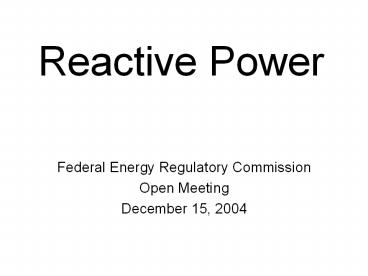AEP Methodology - PowerPoint PPT Presentation
Title: AEP Methodology
1
Reactive Power
Federal Energy Regulatory Commission Open
Meeting December 15, 2004
2
Reactive Power Policy
- Review of Current Policy
- Blackout
- New Generation Filings
- Staff White Paper in Progress
- March 3, 2005 Technical Conference (tentative
date)
3
Reactive Power Sources Users
Sources Generators, Transmission Equipment
(Capacitors, Static Var Compensators) Users
Transmission Lines, Transformers, Loads (motors)
Photos courtesy of Areva Transmission
Distribution, Hitachi, and NREL
4
AEP Methodology
- Generator and its exciter
- Accessory electric equipment that supports the
operation of the generator exciter and - Remaining total production investment required to
provide real power and operate the exciter
Apply allocation factor to sort annual revenue
requirements of these components between real and
reactive power
5
AEPs Financial Impact
- Estimate of all Form 1 reactive power charges is
3.5 to 4.0 billion
6
Goal of Reactive Power Policy
- Promote Reliable and Efficient Infrastructure
Investment, Production, and Customer Use
7
Market Issues
- Comparable Treatment of Generation Resources
- Interconnection Standards
- Reactive Power Planning and Procurement
- Supply Incentives
- Demand Side Incentives
- Public Good
8
Reactive Power Capacity Options
- Cost of Service
- Forward Market Procurement
- Pay Nothing
9
Reactive Power Real-Time Options
- No Payment within Bandwidth, Opportunity Costs
Outside - Strict Opportunity Cost
- Market Clearing Prices
- Fixed Payment
10
Major Conclusions
- Align incentives with desired outcomes
- Pay for reactive power
- Apply comparability to reactive power
- Treat capability and production differently
- Pay more for dynamic than static capability
- Review AEP method
- Pay all sources same price for production
- Mitigate existing market power
- Entry may reduce future market power

